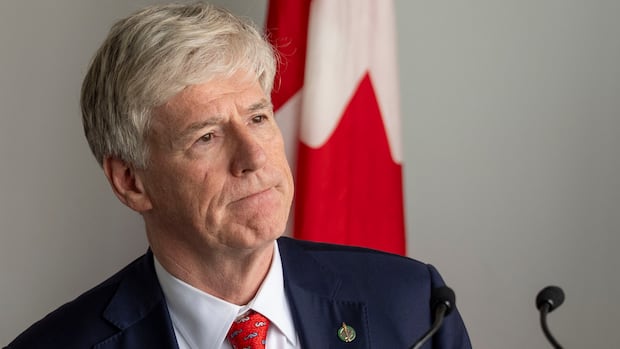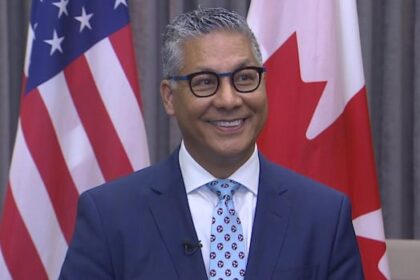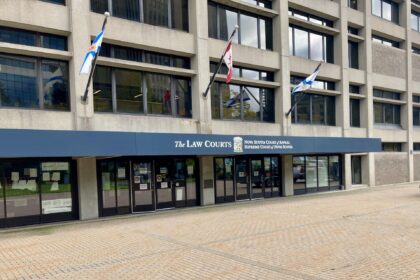PoliticsAhead of the release of Prime Minister Mark Carney’s climate competitiveness strategy, his energy minister offered some hints of what will be included when it’s introduced in Tuesday’s budget. Climate competitiveness strategy expected to be introduced in federal budgetDavid Thurton · CBC News · Posted: Oct 30, 2025 4:00 AM EDT | Last Updated: 3 hours agoListen to this articleEstimated 4 minutesMinister of Energy and Natural Resources Tim Hodgson says the government is looking at three ‘levers’ to focus its climate and energy policy. (Christinne Muschi/The Canadian Press)Ahead of the release of Prime Minister Mark Carney’s climate competitiveness strategy, his energy minister offered some hints of what will be included when it’s introduced in Tuesday’s budget. Energy and Natural Resources Minister Tim Hodgson spoke Wednesday ahead of meetings with officials and fellow G7 environment and energy ministers.Stakeholders in the environment and clean tech space had expected Ottawa to release the strategy ahead of the two-day G7 meeting, which officially begins Thursday in Toronto.But without mentioning the climate strategy specifically, Hodgson spoke about three levers guiding the government’s work.One involves “tactically using” public funding and tax credits to lessen risk and spur investment in “first-of-a-kind projects,” Hodgson said. The goal, the minister said, is ensuring the Canadian economy “stays competitive and Canadian products compete — and win — in a low-carbon world.”The minister suggested Canada’s burgeoning carbon capture, storage and removal sector could be de-risked and scaled with government funding.He cited Arca, a Canadian company that on Wednesday announced it had signed a deal with Microsoft to remove carbon dioxide from the atmosphere. The company has received funding from NorthX Climate Tech — a Canadian organization supported by Natural Resources Canada. Hodgson said Ottawa is also focused on creating an environment of regulatory certainty which requires predictable policies, faster timelines and reliable permitting. The federal government is already in the process of implementing its law to fast-track major resource projects.The minister said the final lever is the use of artificial intelligence to make energy systems “smarter, faster and more resilient.””AI is already reshaping how we produce, move and consume energy,” Hodgson said. “It is helping operators predict grid demand in real time, accelerating materials discovery for better batteries and optimizing renewable energy like wind farms.”Anniversary of emissions cap draft A senior federal government source not authorized to speak publicly says the first two levers —incentivizing more investment in clean tech innovation and providing certainty to industry — are “relevant” to the climate competitiveness strategy.Hodgson’s remarks made no mention of the future of the proposal to cap industrial emissions. The budget date, Nov. 4, marks a year since the federal government released its proposed regulations to impose a hard cap on emissions from the oil and gas sector — the largest share of Canada’s emissions.A former federal government adviser on climate policy, Louise Comeau, said Hodgson is signalling that the Carney government favours carbon capture and storage over an emissions cap.Carbon capture, yet to be proven at scale, has been proposed as a pathway for the cement, steel and oil and gas industries to maintain or grow production with lower emissions.”I don’t think it’s a secret that the proposed oil and gas cap will not be put into regulation in favour of investment in carbon capture and storage,” said Comeau, a former member of Ottawa’s arm’s-length Net Zero Advisory Body.Hodgson also mentioned several other initiatives for low-carbon power generation that Ottawa is leading on, including nuclear plant life extensions, small modular reactors, the development of natural gas with carbon capture and storage and the integration of grid-scale battery storage. WATCH | Will Carney cut climate targets?:After pausing Canada’s EV mandate, will Carney cut climate targets?Prime Minister Mark Carney did not confirm whether he’d keep Canada’s 2030 and 2035 emissions targets in place in his response to a question about changing the goals on Monday. Pembina Institute transportation program director Adam Thorn analyzes how much Carney’s pause of the federal EV mandate jeopardizes the targets, and what Canada can still do to save the emissions. For heavy transportation and other sectors where emission reduction has been challenging, Hodgson spoke about clean hydrogen and sustainable biofuels. The Canadian Climate Institute’s recent analysis has shown Canada won’t meet its 2030 climate targets, where Canada committed to slashing emissions by at least 40 per cent below 2005 levels.At the rate Canada is going, according to the institute, the country would be lucky to get more than halfway there.The federal government’s own January greenhouse gas projections show that Canada will fall short of its climate targets.Since Carney took office, he has cancelled the consumer carbon price and paused the electric vehicle availability standard, without proposing new measures to offset the lost emissions reductions.ABOUT THE AUTHORDavid Thurton is a senior reporter in CBC’s Parliamentary Bureau. He covers daily politics in the nation’s capital and specializes in environment and energy policy. Born in Canada but raised in Trinidad and Tobago, he’s moved around more times than he can count. He’s worked for CBC in several provinces and territories, including Alberta and the Northwest Territories. He can be reached at david.thurton@cbc.caLinkedInTwitter
Energy minister hints at support for carbon capture in climate strategy, no mention of emissions cap











